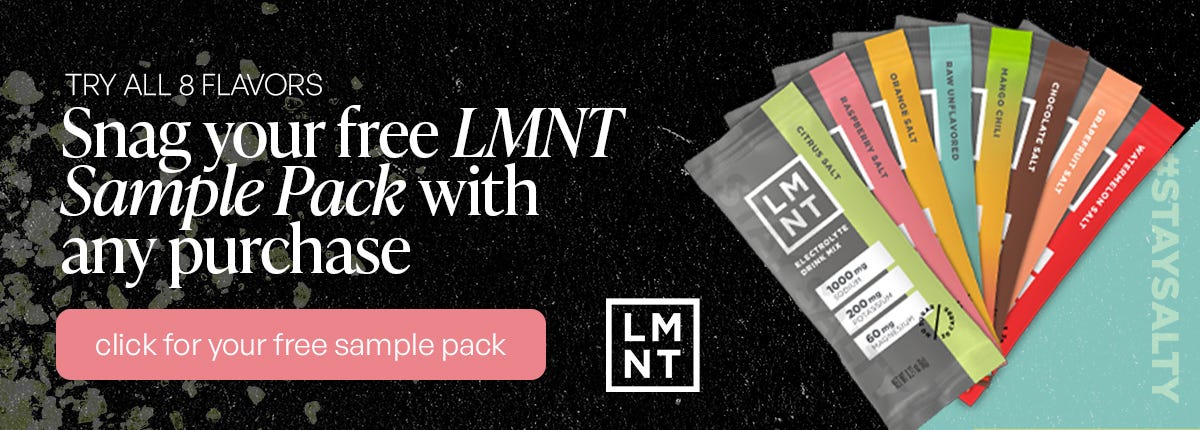Ten things I wish I knew as a new hiker
Summer hiking is in full swing, but it's not too late to level up your game
This issue is sponsored by LMNT electrolytes, my hiking ride-or-die. Whether I’m adding their drink mix into my water reservoir or packing a new Sparkling LMNT in my car cooler, LMNT keeps me energized, focused, and well hydrated on the trail. Get a free sampler 8-pack of LMNT drink mix with any purchase.
I’ve written a lot about hiking—how to get started, what kind of clothing to wear, how to stay safe, and what’s in my pack. But every time I hike, I think to myself, “Oh, this is a great tip I should share with people.” Today, I’ll compile those tips into one quick read to help you hike more comfortably, safer, and with more joy. In no particular order:
Tip 1: One headphone (max)
If you’re new to hiking alone, it might feel weird to head out on the trail with nothing in your ears. However, headphones (especially noise-canceling) are a real safety issue. You want to be able to hear trail runners, mountain bikers (especially coming downhill), rattlesnakes, bears or moose, or other hikers trying to share a warning or heads-up on the trail. If you want to wear headphones, leave one out so you can be more aware of your environment—or let nature be your soundtrack. (And for the love of God, please don’t play music on an external speaker.)
Tip 2: Mountain biker etiquette
Speaking of mountain bikers, technically YOU have the right of way on a trail. In practice, however, encountering bikers on a trail (especially if they’re going downhill) usually requires you to step aside to let them blaze past. If you share a trail with bikers, stay alert. If you hear “on your left” or some other call, don’t waste time looking, just step to the right. Also, it’s good etiquette for bikers to let you know how many are in their group, so you don’t step back onto the trail only to get clobbered by the next guy. They might say, “just me” or “two more,” but if they don’t, you should ask, “just you?”
Tip 3: Go slower than you are (probably)
When you’re hiking uphill, inertia (the tendency of an object in motion to stay in motion) is a powerful force. If you start off too fast, your legs, lungs, or both will burn out fast, and you’ll have to stop and rest. Repeating that up this hill wastes a lot of energy. Ideally, you’ll want to pick a pace that is slow enough that you can stay moving, even on the uphill. Your speed will vary based on the terrain, but resist the urge to speed up if you get a blessedly flat section. Instead, use that time to recover before the next climb. I promise, you’ll use less energy and your entire hike will feel more comfortable.
Tip 4: Mix your LMNT flavors
I always pop at least two LMNT drink mixes in my 3L water reservoir. I used to pick two of the same flavor, but one day I tried mixing two flavors I don’t love—Watermelon and Orange. To my surprise and delight, the combination of these flavors was like a tropical explosion in my mouth! From then on, I mix and match my electrolytes. Favorite combos include Grapefruit and Orange (citrus-pa-looza); Mango Chili and Raw (it tamps down on the spice, which I appreciate on the trail); and Citrus and Grapefruit (light and tangy).
Tip 5: Bring poles in two specific scenarios
I didn’t hike with poles for years, and I’m mad at myself for it. Poles can function as a “third limb,” offering stability, support, and safety. I don’t carry them often, but when the trail is really steep or I have water crossings, they’re a godsend. This is especially true on long hikes, when your legs may already be tired, or early-season water crossings when the water can be dangerously high and fast. (Even if there’s a log or boards across the water, poles can give you another point of contact to avoid a fall.)
Tip 6: Check the weather where you’re going, not where you live
The elevation difference between where I live and where I hike is around 5,000 feet. The weather in these two environments can be dramatically different; temps are colder, wind is windier, and rain and thunderstorms are far more dangerous on a summit or trail. I always check the weather the morning before I leave for the latest forecast, but I look at conditions near the mountains, not at home. In Salt Lake City, that means searching for weather conditions at the ski resorts at the top of the canyons, like Brighton or Alta. In Jackson, it means looking at the weather in Grand Teton National Park, not Jackson Hole. Do some research before your hike; find the nearest town, resort, or tourist attraction; and base your weather search there.
Tip 7: Hustle up, take your time going down
My trails can get really busy by 10 AM. I strongly prefer having the trail and destination experience mostly to myself, so I get a very early start, and hustle up to the summit, lake, or waterfall. By “hustle,” I mean that I maintain my comfortable pace, but I don’t stop a million times for pictures, snacks, or to take in the sights. My goal is to get up to the end point efficiently, so I can spend as much time at the destination on my own before it gets crowded. Yes, I still take pics on the way up—the light is so good that early—but I’ll stop, snap, and move along. Yes, I snack on the way up, but I pick easily digestible snacks so I can munch while I move. Having an extra half-hour at the summit or lake all by myself is totally worth it. Then on the way back down, I’ll stop and take as much time as I want to snap more shots, sit and take in the view, or chat with strangers.
Tip 8: Leave comfort items in the car
The best feeling in the world is changing into a fresh pair of shoes when you get back to the car. Packing wet wipes (to clean your feet and hands), a fresh pair of socks (if that’s how you roll), and your most comfortable sandals or slides will make you feel like a whole new person. (Bonus points for also cracking the cold LMNT Sparkling in your cooler—unbeatable.)
Tip 9: Buy extras and leave them in your pack
I’ve lent so many people bug spray and sunscreen on the trail—but I never forget these items. That’s because I’ve bought travel sizes of DEET and SPF 50 spray; stocked up on lip balms and hair ties; and just leave them in my pack. I do the same with Kula Cloths (I have many extras, so the second I get back, I swap the dirty one with a clean one for next time); contact lenses (I keep two dailies in my pack, just in case); and even my inhaler (I had my doctor prescribe me an extra refill).
Tip 10: Always pack a book
If you like to read, there is no better opportunity to flip some pages than on a hike. (And every time I think, “Nah, I won’t want to read today,” I regret not packing one.) You can almost always pull off-trail and find a quiet slice of lakeside, river bank, mountaintop, or cliffside views where you can just sit and chill. (Bonus: Pack a small towel to help smooth over rough terrain for your butt.) In the middle of a chunky hardcover? Pack it anyway! A little extra weight only improves your cardio. (Or, invest in a Kindle and always have a variety of reading materials on download.)
Have you heard or discovered a hiking tip that totally changed your time on the trail? Share it in comments!





So great! Thank you! Second solo hike today. I still have fear of hiking by myself but last week I noticed the people hiking were kind!
Hiking with kids: bring 3x the snacks (power ups) you think you’ll need and turn the hike into a scavenger hunt.
Also: a tiny first aid kit with bandaids, mole skin, etc is handy. Target sells small kits in a tin. I keep one in my car and one with the hiking gear